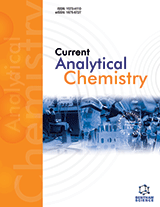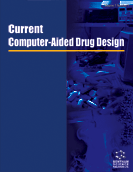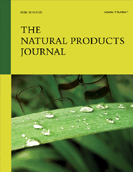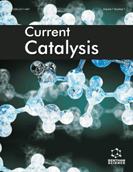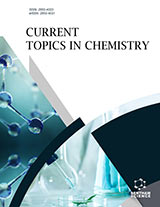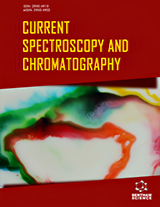Abstract
The voltammetric behavior of cinnamic acid (CA) and 3, 4-dihydroxy benzoic acid (BA) at an glassy carbon disc electrode has been investigated. The obtained cyclic voltammograms showed that their oxidation peaks were overlapped and it was difficult to determine them individually from a mixture without separation. To overcome this limitation, partial least squares (PLS) modeling, as a powerful multivariate statistical tool, was proposed for the resolution of the overlapped voltammetric signals from mixtures of CA and BA. With the help of the orthogonal signal correction (OSC), the unrelated information was removed and the results were confirmed. In this procedure, the genetic algorithm (GA) was used for the potentials selection for PLS. In addition, OSC-GA-PLS for the first time was used and the results of this method were better than those of the other methods. The proposed method was suitable for the determination of CA and BA in mixtures.
Keywords: Chemometrics, Genetic algorithm, Orthogonal signal correction, Partial least squares, Cinnamic acid, 3,4-Dihydroxy benzoic acid
Current Analytical Chemistry
Title: Development of a New Combined Chemometrics Method, Applied in the Simultaneous Voltammetric Determination of Cinnamic Acid and 3, 4-Dihydroxy Benzoic Acid
Volume: 5 Issue: 1
Author(s): Siavash Riahi, Mohammad R. Ganjali, Abdolmajid B. Moghaddam, Eslam Pourbasheer and Parviz Norouzi
Affiliation:
Keywords: Chemometrics, Genetic algorithm, Orthogonal signal correction, Partial least squares, Cinnamic acid, 3,4-Dihydroxy benzoic acid
Abstract: The voltammetric behavior of cinnamic acid (CA) and 3, 4-dihydroxy benzoic acid (BA) at an glassy carbon disc electrode has been investigated. The obtained cyclic voltammograms showed that their oxidation peaks were overlapped and it was difficult to determine them individually from a mixture without separation. To overcome this limitation, partial least squares (PLS) modeling, as a powerful multivariate statistical tool, was proposed for the resolution of the overlapped voltammetric signals from mixtures of CA and BA. With the help of the orthogonal signal correction (OSC), the unrelated information was removed and the results were confirmed. In this procedure, the genetic algorithm (GA) was used for the potentials selection for PLS. In addition, OSC-GA-PLS for the first time was used and the results of this method were better than those of the other methods. The proposed method was suitable for the determination of CA and BA in mixtures.
Export Options
About this article
Cite this article as:
Riahi Siavash, Ganjali R. Mohammad, Moghaddam B. Abdolmajid, Pourbasheer Eslam and Norouzi Parviz, Development of a New Combined Chemometrics Method, Applied in the Simultaneous Voltammetric Determination of Cinnamic Acid and 3, 4-Dihydroxy Benzoic Acid, Current Analytical Chemistry 2009; 5 (1) . https://dx.doi.org/10.2174/157341109787047925
| DOI https://dx.doi.org/10.2174/157341109787047925 |
Print ISSN 1573-4110 |
| Publisher Name Bentham Science Publisher |
Online ISSN 1875-6727 |
 24
24
- Author Guidelines
- Bentham Author Support Services (BASS)
- Graphical Abstracts
- Fabricating and Stating False Information
- Research Misconduct
- Post Publication Discussions and Corrections
- Publishing Ethics and Rectitude
- Increase Visibility of Your Article
- Archiving Policies
- Peer Review Workflow
- Order Your Article Before Print
- Promote Your Article
- Manuscript Transfer Facility
- Editorial Policies
- Allegations from Whistleblowers
- Announcements
Related Articles
-
An Integrated Platform for Bio-Analysis and Drug Delivery
Current Pharmaceutical Biotechnology Possible Consequences of Blocking Transient Receptor Potential Vanilloid 1
Current Pharmaceutical Biotechnology 1,2,4-Oxadiazoles Identified by Virtual Screening and their Non-Covalent Inhibition of the Human 20S Proteasome
Current Medicinal Chemistry Metabolomic Biomarkers in Gynecology: A Treasure Path or a False Path?
Current Medicinal Chemistry Synthesis of new 6-Spiro (Testosteron-3′-yl)-Hexahydro-3-Thioxo-1, 2, 3-Triazin-5-Ones and Related Derivatives as Affecting Enzymatic Agents
Current Organic Synthesis The Plasma Levels of hsa-miR-19b-3p, hsa-miR-125b-5p, and hsamiR- 320c in Patients with Asthma, COPD and Asthma-COPD Overlap Syndrome (ACOS)
MicroRNA Evaluation of Fluorescence Resonance Energy Transfer Approaches as a Tool to Quantify the Stability of Antisense Oligodeoxynucleotides
Current Pharmaceutical Analysis Immunoproteasome-Selective Inhibitors: A Promising Strategy to Treat Hematologic Malignancies, Autoimmune and Inflammatory Diseases
Current Medicinal Chemistry Improving Nutritional Quality of Plant Proteins Through Genetic Engineering
Current Genomics Structure Conversion and Structure Separation of G-Quadruplexes Investigated by Carbazole Derivatives
Current Pharmaceutical Design Zebrafish: Predictive Model for Targeted Cancer Therapeutics from Nature
Current Cancer Drug Targets Supramolecular Chiro-Biomedical Assays and Enantioselective HPLC Analyses for Evaluation of Profens as Non-Steroidal Anti-Inflammatory Drugs, Potential Anticancer Agents and Common Xenobiotics
Current Drug Discovery Technologies Mathematical Methods to Analysis of Topology, Functional Variability and Evolution of Metabolic Systems Based on Different Decomposition Concepts
Current Drug Metabolism Rapidly Increasing Trends in Oropharyngeal Carcinoma Assessed by Worldwide Epidemiologic Analysis
Current Cancer Therapy Reviews α2-Adrenoceptors Enhance Cell Proliferation and Mammary Tumor Growth Acting Through both the Stroma and the Tumor Cells
Current Cancer Drug Targets Purification and Kinetics of Bovine Kidney Cortex Glutathione Reductase
Protein & Peptide Letters Molecular Properties and Medical Applications of Peptide Nucleic Acids
Mini-Reviews in Medicinal Chemistry Changing Faces of Transcriptional Regulation Reflected by Zic3
Current Genomics Immune-Neuroendocrine Interactions Involving Thymus and Pineal Gland in Stem Cell Therapy of Age-Related Diseases
Immunology, Endocrine & Metabolic Agents in Medicinal Chemistry (Discontinued) Synthesis and Antiproliferative Activity of New Coumarin-Based Benzopyranone Derivatives Against Human Tumor Cell Lines
Medicinal Chemistry


